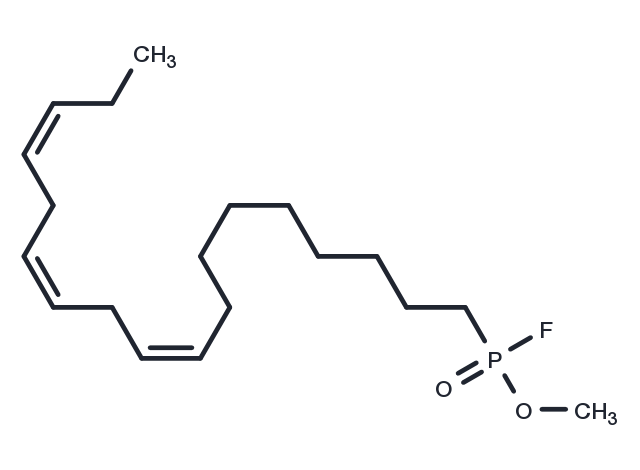Powder: -20°C for 3 years | In solvent: -80°C for 1 year


Methyl α-Linolenyl Fluorophosphonate is an inhibitor of phospholipases. Methyl α-Linolenyl Fluorophosphonate (MLnFP), an analog of methyl Arachidonyl Fuorophosphonate (MAFP), has not been completely investigated for its pharmacological activity.

| Pack Size | Availability | Price/USD | Quantity |
|---|---|---|---|
| 1 mg | Inquiry | Inquiry | |
| 100 mg | Inquiry | Inquiry | |
| 500 mg | Inquiry | Inquiry |
| Description | Methyl α-Linolenyl Fluorophosphonate is an inhibitor of phospholipases. Methyl α-Linolenyl Fluorophosphonate (MLnFP), an analog of methyl Arachidonyl Fuorophosphonate (MAFP), has not been completely investigated for its pharmacological activity. |
| In vitro | In vitro: MethylArachidonyl Fluorophosphonate (MAFP) was reported to be a selective, active-site directed, irreversible inhibitor of cytosolic phospholipase A2 (cPLA2). MAFP could also potently inhibit the Ca2+-independent cytosolic phospholipase A2 (iPLA2) in a concentration-dependent manner. Such inhibition was not reversed upon extensive dilution of the enzyme into the assay mixture. The Preincubation of iPLA2 with MAFP led to a linear and time-dependent inactivation of enzyme activity, and the enzyme was protected from inactivation by the reversible inhibitor. The ability of MAFP to inhibit the iPLA 2 indicated that this enzyme proceeded via an acyl-enzyme intermediate. Further testing showed that MAFP could not inhibit the CoA-dependent acyltransferase, arachidonoyI-CoA synthetase, or CoA-independent transacylase activities. Therefore, MAFP was not a general inhibitor for enzymes acting on arachidonoyi substrates [1]. |
| Molecular Weight | 344.4 |
| Formula | C19H34FO2P |
| CAS No. | T22975 |
Powder: -20°C for 3 years | In solvent: -80°C for 1 year
Ethanol: ≤5mg/mL
DMSO: 5mg/ml
You can also refer to dose conversion for different animals. More
bottom
Please see Inhibitor Handling Instructions for more frequently ask questions. Topics include: how to prepare stock solutions, how to store products, and cautions on cell-based assays & animal experiments, etc.
Methyl α-Linolenyl Fluorophosphonate T22975 Others Methyl αLinolenyl Fluorophosphonate Methyl a-Linolenyl Fluorophosphonate Methyl α Linolenyl Fluorophosphonate Methyl alpha-Linolenyl Fluorophosphonate inhibitor inhibit
